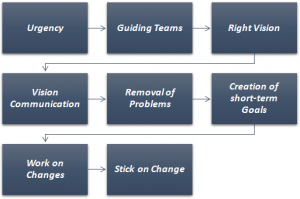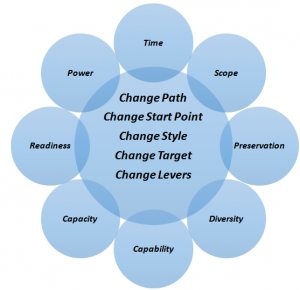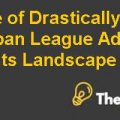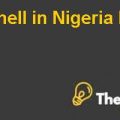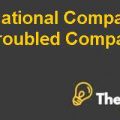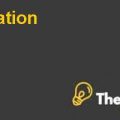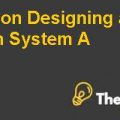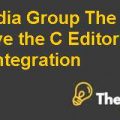Deborah Jamieson and the University College London Hospitals Case Study Solution
Micheal Smets Model:
The leadership approach of Deborah on the basis of Smets Model demonstrates that the strategic plan used by the management of UCLH for pilot purpose had provided hospital with positive outcomes. The need to design mechanism which better fit on the data assumed by the economists. The strategy plan proposed by Deborah had less policies and less complex procedures to be followed by the management and employees of hospital. As the implementation of the strategic plan proposed was used as a pilot approach to know its outcome.As the pilot approach was successful and showed positive results.However,the leadership of Deborah was commendable, but it was just a temporary approach. With the successful outcomes, this approach can be used as long –term strategic plan to strengthen the organization. But there is a need to create policies for specific purposes.
Jarzabkowski Model:
This model is known as strategy as practice model. This model used for the analysis of outcomes of strategic implementation as practice. On the basis of this model, the strategic plan implemented by Deborah as practice was to evaluate its outcome so that it can be implemented as a long term strategic plan. In context to issues of hospitals, she proposed two solutions, which were training of nurses as well as redesigning of service map that was followed by hospital. The strategic plan included prominent role of Deborah in leading it to success. However, employees and other management members also contributed their efforts the same way.This involved the launch of training programs and recruitment of trained nurses for efficient pre-operative and pre-admission assessment. As a result, the issue of communication gap between management and staff was resolved, the satisfaction level of patients and employees had increased, the services provided with high quality equipment.(Santacana, 2008)
Bruke- Litwin Model:
Transformational factors
External Environment: The University College London hospital’s success was greatly affected by the services that were lacking in the hospital, and were provided by other healthcare organizations. On the other hand, financial status of the hospital was nicely managed by the NHS Trust in association with the Labour Party.
Vision, mission and Strategy:The vision of setting a mission of redesigning the service map and training of nursing staff was thought by Deborah. This was to improve the service as well as treatment quality at low cost.It is not only Deborah’s wish but employees and management also wanted the same.For this purpose, Deborah designed a strategy that was initiated with the treatment centre transformation.
Leadership:Deborah had the leadership ability, and she knew well how to transform any organization in order to direct it on the path of success. She was an experienced professional who knew the responsibilities better and valued the fulfilment of these responsibilities. The style of her leadership involved encouragement of employees and their training in order to improve their skills and efficiency in work.
Organizational Culture:The existing culture of the organization involved employees of mixed culture. Due to this difference, there was no strong communication between employees and management, which is one of the key obstacle in the success of any organization.
Individual and Organizational Performance: After the transformation of hospital and training of nurses, the outcome was positive. By improved skills of nurses and transformed organizational structure, the satisfaction level of customers as well as staff had increased.
Transactional factors
Structure: The reorganized structure of organization of was quite effective with the placement of relatable experienced staff in specific departments. There was a criteria set for the monthly meeting to evaluate the output in a better way.
Management Practices: The practices of management involves the evaluation of strategic plans implementation.This is determined by the behaviour of managers, work protocols, level of communication and control. Hence, the management of hospital was considering all the practices needed for the betterment of the hospital.
Work climate:Before the joining of Deborah, the work climate at the UCLH was not worthy, due to the differential cultural values. Later on, this gap was removed by the collaboration of management with employees in the improvement of the hospital they worked in. After the issue of communication gap had been resolved, the hospital started to show noticeable progress.
Requirement of task and the performer abilities:The assigning of task to employees needed to be done by knowing the ability of performer, if he/she is able to perform task well. Thus, the management of UCLH assisted staff in polishing their abilities to do work by training program, and the output was commendable.
Needs and Values:The requirement of work to be done efficiently by employees, there is a need to make sure if employee is stress free. Due to stress, the creativity and innovation of one’s mind gets out of sight. So, it is important to take care of the employees’ needs in order to keep them free of psychological stress, which may affect the organization services efficiency.
Motivation: It is the key factor to encourage employees to bring out their creative site. This is impossible if one is not appreciated for his/her work. Deborah realized the need of appreciation for the employees working in the UCLH. After receiving encouraging and appreciating comments from their seniors; the employees enhanced their interest towards work.(Nico Martins, 2009)
Conclusion:
The UCL hospital NHS Trust performance was analysed using different models. The overall outcome of the analysis shows that the leadership of Deborah at UCLH with the association of management and employees had been successful. As the outcomes of the analysis demonstrates that the satisfaction level of patients and employees was increased regarding the services they received from the hospital. Similarly, the transformation of service map also proved to be a source of increased income, low cost and high quality services for the patients; providing them a one stop solution for all their problems.

